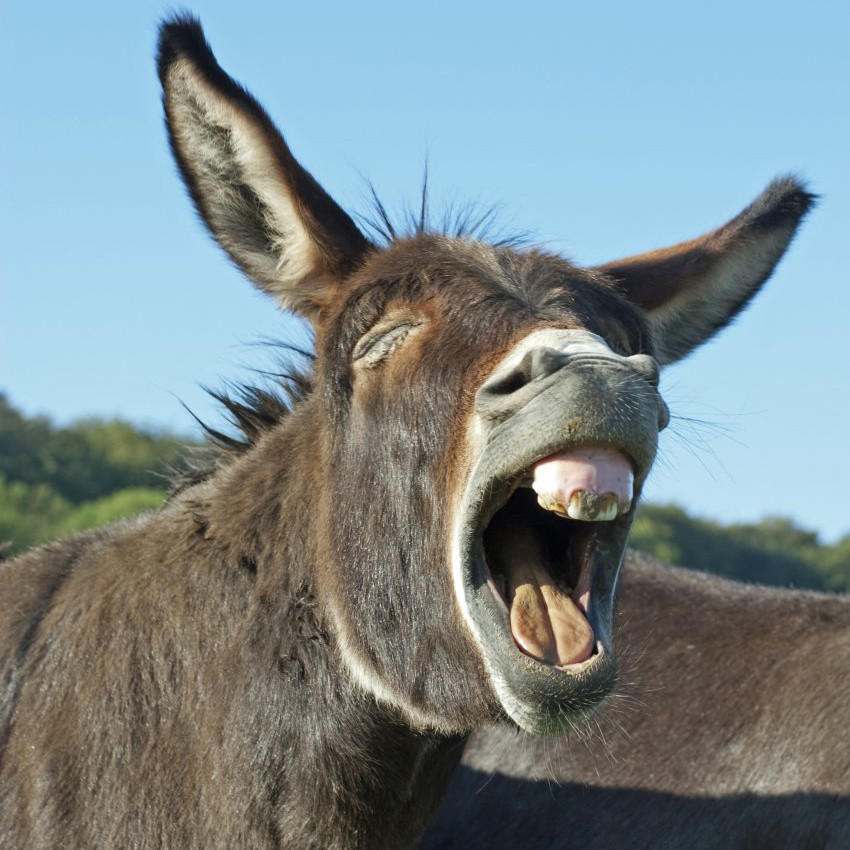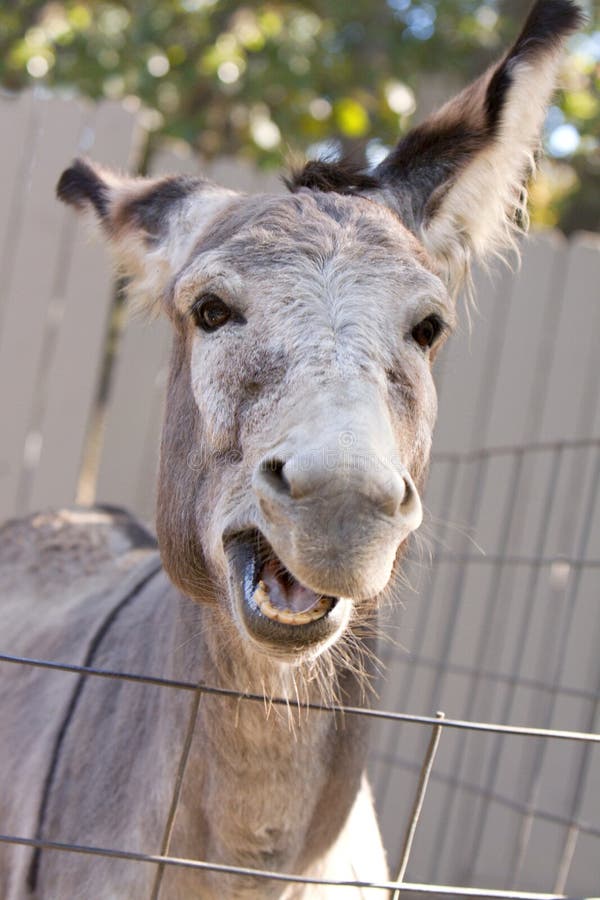Braying Donkey
A braying donkey is a donkey that is making a loud, harsh sound. Donkeys bray for a variety of reasons, including to communicate with other donkeys, to attract attention, or to express distress. The sound of a donkey braying can be quite distinctive and can often be heard from a long distance away.
- Communication: Donkeys bray to communicate with other donkeys.
- Attention: Donkeys bray to attract attention.
- Distress: Donkeys bray to express distress.
- Characteristic Sound: The sound of a donkey braying is quite distinctive.
- Loud: Donkeys bray loudly.
- Harsh: Donkeys bray harshly.
- Long Distance: The sound of a donkey braying can be heard from a long distance away.
Donkeys are members of the horse family, and they are native to Africa. Donkeys have been domesticated for thousands of years, and they are now used for a variety of purposes, including transportation, farming, and companionship. Donkeys are generally gentle and friendly animals, but they can be quite stubborn.
1. Communication
Donkeys are social animals that rely on communication to interact with each other. Braying is one of the most important ways that donkeys communicate. They use brays to communicate a variety of messages, including danger, food, and mating. Donkeys also bray to establish and maintain social bonds.
- Territorial Defense: Donkeys bray to defend their territory from other donkeys or predators.
- Food Sources: Donkeys bray to let other donkeys know about food sources.
- Mating Calls: Male donkeys bray to attract females.
- Social Bonding: Donkeys bray to maintain social bonds with other donkeys.
The ability to communicate effectively is essential for donkeys. Braying allows them to share important information with each other and to maintain social bonds. Without brays, donkeys would have difficulty surviving in the wild.
2. Attention
Donkeys bray to attract attention for a variety of reasons. One reason is to alert other donkeys to danger. If a donkey sees a predator, it will bray loudly to warn the others. Another reason donkeys bray to attract attention is to find food. If a donkey is hungry, it will bray to let other donkeys know that it is looking for food. Finally, donkeys bray to attract attention from humans. If a donkey is lost or injured, it will bray to attract attention from humans who can help it.
Attracting attention is an important part of donkey communication. Donkeys use brays to communicate with each other and with humans. By understanding why donkeys bray to attract attention, we can better understand their behavior and how to interact with them.
Here are some examples of how donkeys use brays to attract attention:
- A donkey may bray loudly if it sees a predator, such as a wolf or a coyote.
- A donkey may bray if it is hungry and is looking for food.
- A donkey may bray if it is lost or injured and is looking for help.
- A donkey may bray if it is excited or playful.
- A donkey may bray if it is trying to get the attention of a human.
By understanding why donkeys bray to attract attention, we can better understand their behavior and how to interact with them. For example, if we see a donkey braying, we can try to determine why it is braying and then take appropriate action. If the donkey is braying because it is in danger, we can try to help it. If the donkey is braying because it is hungry, we can try to find it some food. If the donkey is braying because it is lost or injured, we can try to help it find its way home or get it to a veterinarian.
3. Distress
Donkeys bray to express distress when they are in pain, scared, or otherwise upset. This is a natural way for them to communicate their distress to other donkeys and to humans. Distress brays are often loud and harsh, and they can be heard from a long distance away. This helps to ensure that other donkeys and humans can hear the donkey's distress call and come to its aid.
It is important to be able to recognize the signs of distress in donkeys so that you can help them. Some of the signs of distress in donkeys include:
- Braying loudly and harshly
- Pinning their ears back
- Stomping their feet
- Kicking
- Biting
If you see a donkey exhibiting any of these signs of distress, it is important to try to determine the cause of the distress and to help the donkey if possible. Some of the things that you can do to help a distressed donkey include:
- Removing the donkey from the source of distress
- Calming the donkey down
- Providing the donkey with food and water
- Calling a veterinarian if the donkey is injured or sick
By understanding the connection between distress and braying in donkeys, you can better help donkeys in distress. This can help to improve the welfare of donkeys and to build a stronger bond between donkeys and humans.
4. Characteristic Sound
The sound of a donkey braying is a unique and easily recognizable sound. It is a loud, harsh sound that can be heard from a long distance away. Donkeys bray for a variety of reasons, including to communicate with other donkeys, to attract attention, and to express distress. The distinctive sound of a donkey braying is due to the donkey's vocal cords. Donkeys have long, thick vocal cords that vibrate rapidly when they bray. This vibration produces the loud, harsh sound that is characteristic of donkey brays.
- Communication: Donkeys use their distinctive brays to communicate with other donkeys. They use different types of brays to convey different messages, such as danger, food, and mating.
- Attention: Donkeys also bray to attract attention. They may bray if they are lost, hungry, or injured.
- Distress: Donkeys bray to express distress. They may bray if they are in pain, scared, or otherwise upset.
- Recognition: The distinctive sound of a donkey braying makes it easy to recognize donkeys from a distance. This is important for donkeys, as it allows them to identify each other and to stay together in herds.
The distinctive sound of a donkey braying is an important part of donkey communication. It allows donkeys to communicate with each other and to express their needs. The distinctive sound of a donkey braying is also important for humans, as it allows us to recognize donkeys and to understand their behavior.
5. Loud
Donkeys are known for their loud brays. These brays can be heard from a long distance away and are used for a variety of purposes, including communication, attracting attention, and expressing distress.
- Communication: Donkeys use their brays to communicate with other donkeys. They use different types of brays to convey different messages, such as danger, food, and mating.
- Attention: Donkeys also bray to attract attention. They may bray if they are lost, hungry, or injured.
- Distress: Donkeys bray to express distress. They may bray if they are in pain, scared, or otherwise upset.
- Volume Donkeys have long, thick vocal cords that vibrate rapidly when they bray. This vibration produces the loud, harsh sound that is characteristic of donkey brays.
The loudness of a donkey's bray is an important part of donkey communication. It allows donkeys to communicate over long distances and to express their needs clearly. The loudness of a donkey's bray is also important for humans, as it allows us to recognize donkeys and to understand their behavior.
6. Harsh
The harshness of a donkey's bray is an important part of donkey communication. It allows donkeys to communicate over long distances and to express their needs clearly. The harshness of a donkey's bray is also important for humans, as it allows us to recognize donkeys and to understand their behavior.
- Communication: Donkeys use their harsh brays to communicate with other donkeys. They use different types of brays to convey different messages, such as danger, food, and mating.
- Attention: Donkeys also bray harshly to attract attention. They may bray if they are lost, hungry, or injured.
- Distress: Donkeys bray harshly to express distress. They may bray if they are in pain, scared, or otherwise upset.
- Warning: The harshness of a donkey's bray can also be used as a warning to other animals. For example, donkeys may bray harshly to warn other animals of a predator.
The harshness of a donkey's bray is an important part of donkey communication. It allows donkeys to communicate over long distances, to express their needs clearly, and to warn other animals of danger.
7. Long Distance
The ability of a donkey's bray to be heard from a long distance away is an important aspect of donkey communication. It allows donkeys to communicate with each other over long distances, even in challenging environments. This ability is due to several factors, including the unique vocal anatomy of donkeys and the acoustic properties of their bray.
- Vocal Anatomy: Donkeys have long, thick vocal cords that vibrate rapidly when they bray. This vibration produces a loud, harsh sound that can be heard from a long distance away.
- Acoustic Properties: The acoustic properties of a donkey's bray are such that it can travel long distances without losing its intensity. This is due to the low frequency of the bray, which allows it to travel through dense vegetation and other obstacles.
- Communication: Donkeys use their long-distance brays to communicate with each other over long distances. They use different types of brays to convey different messages, such as danger, food, and mating.
- Warning: The long-distance range of a donkey's bray can also be used as a warning to other animals. For example, donkeys may bray to warn other animals of a predator.
The ability of a donkey's bray to be heard from a long distance away is an important part of donkey communication. It allows donkeys to communicate with each other over long distances, to express their needs clearly, and to warn other animals of danger.
FAQs on Braying Donkeys
This section provides answers to frequently asked questions about braying donkeys. These FAQs aim to address common concerns and misconceptions, offering informative and reliable information.
Question 1: Why do donkeys bray?
Answer: Donkeys bray for a variety of reasons, including communication, attracting attention, and expressing distress. They use different types of brays to convey different messages, such as danger, hunger, and mating.
Question 2: How far can a donkey's bray be heard?
Answer: The sound of a donkey's bray can be heard from a long distance away, up to several kilometers in favorable conditions. This is due to the unique vocal anatomy of donkeys and the acoustic properties of their bray.
Question 3: Is a donkey's bray considered loud and harsh?
Answer: Yes, donkey brays are generally characterized as loud and harsh. The loudness is necessary for donkeys to communicate over long distances, while the harshness helps their brays stand out in noisy environments.
Question 4: What is the difference between a donkey's bray and a horse's neigh?
Answer: While both donkeys and horses are members of the equine family, their vocalizations are distinct. A donkey's bray is typically louder, harsher, and more prolonged than a horse's neigh. Additionally, donkeys bray more frequently than horses.
Question 5: Are donkeys known for their intelligence?
Answer: Donkeys are often perceived as less intelligent than horses, but this is a misconception. Donkeys possess a unique set of cognitive abilities and are known for their problem-solving skills, memory, and adaptability.
Summary:
- Donkeys bray for various reasons, including communication, attention-seeking, and expressing distress.
- Donkey brays can travel long distances due to their unique vocal cords and acoustic properties.
- Donkey brays are typically loud and harsh, distinguishing them from horse neighs.
- Despite misconceptions, donkeys are intelligent animals with notable cognitive abilities.
Transition:
These FAQs provide insights into the communication and behavior of braying donkeys. Understanding these aspects helps us appreciate the unique characteristics and ecological roles of these animals.
Conclusion
Through our exploration of the "braying donkey," we have gained insights into the rich and complex communication system of these remarkable animals. Donkeys' distinctive brays serve a multitude of purposes, including conveying messages of danger, attracting attention, expressing distress, and maintaining social bonds.
The unique characteristics of donkey brays, such as their loudness, harshness, and long-distance range, allow them to effectively communicate even in challenging environments. Understanding the significance of braying in donkey behavior not only enhances our appreciation for their intelligence and social dynamics but also underscores the importance of preserving and protecting these valuable creatures.



Detail Author:
- Name : Prof. Desmond Bartoletti
- Username : qhowe
- Email : avery.kirlin@bogan.biz
- Birthdate : 1999-11-19
- Address : 99214 Andres Trail Apt. 740 Ritaview, NM 82496
- Phone : +18062979339
- Company : Rempel, Heathcote and Jaskolski
- Job : Biophysicist
- Bio : Earum ratione qui veritatis et voluptas magni explicabo. Cupiditate alias suscipit sed provident velit ut hic. Dolorum animi fugit id temporibus.
Socials
tiktok:
- url : https://tiktok.com/@vonrueden1992
- username : vonrueden1992
- bio : Dolor iusto omnis magni reiciendis consequatur modi.
- followers : 5754
- following : 2393
twitter:
- url : https://twitter.com/madie.vonrueden
- username : madie.vonrueden
- bio : Nihil et et non omnis neque blanditiis. Et ipsa ex quis quia blanditiis. Qui quia sequi sit aut doloribus. Voluptatum nam aut rerum aut cum.
- followers : 6479
- following : 1741
instagram:
- url : https://instagram.com/madievonrueden
- username : madievonrueden
- bio : Ad adipisci quidem voluptas quia. Soluta est tenetur incidunt quisquam.
- followers : 104
- following : 1125